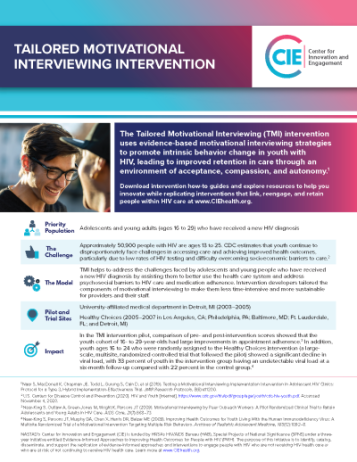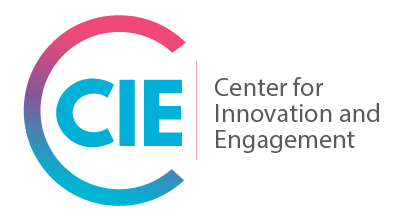
Summary
This communication-centered approach to service delivery provides a compassionate and supportive environment in which to promote intrinsic behavior change among youth 16 to 29 with newly diagnosed HIV. Tailored Motivational Interviewing (TMI) helps youth address psychosocial barriers to HIV care and medication adherence and improve their use of the health care system.
Implementation Resources
Intervention Outcomes
- Clients missed fewer appointments.
- 33% of youth achieved undetectable status (in Healthy Choices, the subsequent randomized controlled trial).
Intervention Components
- Define Priority Youth Characteristics and Data Measures
- Secure Leadership Buy-In
- Assess Staff Competencies and Readiness
- Develop a Youth Advisory Board and Community of Practice
- Recruit TMI Trainers and Staff as Necessary
- Train Staff
- Retain Youth with HIV in Care and Monitor Intervention Fidelity
Cost Analysis
The TMI intervention cost analysis is not currently available. However, you can use the CIE Cost Calculator to create an estimate of the cost of implementing the intervention at your organization.
Challenges and Solutions
| Challenge | Solution |
|---|---|
| Provider availability for training | Leadership and administrative supervision support staff can discuss scheduling options to reduce the time burden experienced by providers and other staff. |
| Staff have prior experience with MI | Gauge staff's MI training and experience and ensure that they are certified in the MI style pertinent to TMI. |
| Staff turnover and participation in the required components of TMI | Internal coaching of team members and engagement with Communities of Practice can ensure that MI becomes established institutional knowledge that is easily disseminated to new staff. |
| Lack of buy-in at the leadership and managerial levels | Highlight the benefits offered by TMI while creating a clear plan for integrating TMI strategies into the existing care structure. Engage Communities of Practice in discussions about strategies for creating buy-in. |
Supplementary Resources
Publications
- Systematic review of the exploration, preparation, implementation, sustainment (EPIS) framework
- Testing a Motivational Interviewing implementation intervention in adolescent HIV clinics: Protocol for a Type 3, Hybrid Implementation-Effectiveness trial
- Motivational Interviewing by peer outreach workers: A pilot randomized clinical trial to retain adolescents and young adults in HIV care
- Improving health outcomes for youth living with the Human Immunodeficiency Virus: A multisite randomized trial of a motivational intervention targeting multiple risk behaviors
- HRSA Readiness assessment and developing project aims (PDF)
Resources
- NASTAD Trauma-Informed Approaches Toolkit
- Behavior Change Consulting. (N.D.) Tailored Motivational Interviewing: An Implementation Toolkit (PDF).
- Healthy Choices – Motivational Enhancement for HIV-related Behaviors: An Implementation Toolkit (PDF)

